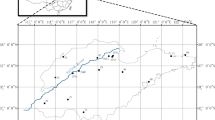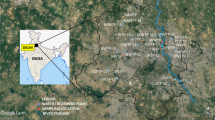Abstract
In this work assays involving chlorinated water samples, which were previous spiked with humic substances or algae blue green and following the production of the THMs for 30 days is described. To implement the assays, five portions of 1,000 ml of water were stored in glass bottles. The water samples were treated with solutions containing 2, 3, 4 and 5 mg l−1 chlorine. The samples aliquots (60 ml) were transferred into the glass vials, 10 ml were removed to have a headspace and 100 μl of the 10 mg l−1 pentafluortoluene bromide solution was added to each vial. The extraction step was performed by adding 10 g of Na2SO4 followed by 5 ml of n-pentane. The vials were stopped with a TFE-faced septum and sealed with aluminum caps. The generated THMs were determined by gas chromatography with electron capture detector using reference solutions with concentration ranging from 8 to 120 μg l−1 THMs. Three assays were monitored during 30 days and chloroform was the predominant compound found in the water samples, while other species of THMs were not detected. The results showed that when the chlorine concentration was increased in water samples containing algae the concentration of THM varied randomly. Nevertheless, in water samples containing humic substances the increase of the THM concentration presented a relationship with the chlorine concentration. It was also observed that chloroform concentration increased with the elapsed time up to one and six days to water samples spiked with humic substances and algae blue green, respectively and decreased along 30 days. By other hand, assays performed using water samples containing decanted algae material showed that THM was not generated by the chlorine addition.
Similar content being viewed by others
References
Chaidou, C. I., Georgakilas, V. I., Stalikas, C., Saraci, M., & Lahaniatis, E. S. (1999). Formation of chloroform by aqueous chlorination of organic compounds. Chemosphere, 39(4), 587–594.
Gibbons, J., & Laha, S. (1999). Water purification systems: A comparative analysis based on the occurrence of disinfection by-products. Environmental Pollution, 106, 425–428.
Governmental decree 518 of March 25 (2004). Quality norms of water supply for human consumption.
Hautman, D. P., & Munch, D. J. (1997). Development of U.S. EPA Method 551.1. Journal of Chromatographic Science, 35, 221–231.
Muttamara, S., Sales, C. I., & Gazali, Z. (1995). The formation of trihalomethane from chemical disinfectants and humic substances in drinking water. Water Supply, 13, 105–117.
Nikolaou, A. D., Golfinopoulos, S. K., Lekkas, T. D., & Kostopoulou, M. N. (2004). DBP levels in chlorinated drinking water: Effect of humic substances. Environmental Monitoring and Assessment, 93, 301–319.
Snider, E. H., & Alley, F. C. (1979). Kinetics of the chlorination of biphenyl under conditions of waste treatment processes. Environmental Science & Technology, 13, 1244–1248.
Sohn, J., Amy, G., Cho, J., Lee, Y., & Yoon, Y. (2004). Disinfection decay and disinfection by-products formation model development: Chlorination and ozonation by-products. Water Research, 38, 2461–2478.
Sohn, J., Gatel, D., & Amy, G. (2001). Monitoring and modeling of disinfection by-products (DBPs). Environmental Monitoring and Assessment, 70, 211–222.
Thacker, N. P., Kaur, P., & Rudra, A. (2002). Trihalomethane formation potential and concentration changes during water treatment at Mumbai (India). Environmental Monitoring and Assessment, 73, 253–262.
Uyguner, C. S., Hellriegel, C., Otto, W., & Larive, C. K. (2004). Characterization of humic substances: Implications for trihalomethane formation. Analytical and Bioanalytical Chemistry, 378, 1579–1586.
Villanueva, C. M., Kogevinas, M., & Grimalt, J. O. (2003). Haloacetic acids and trihalomethanes in finished drinking waters from heterogeneous sources. Water Research, 37, 953–958.
Whitaker, H., Nieuwenhuijsen, M. J., Best, N., Fawell, J., Gowers, A., & Elliot, P. (2003). Description of trihalomethane levels in three UK water suppliers. Journal of Exposure Analysis and Environmental Epidemiology, 13, 17–23.
Williams, D. T., LeBel, G. L., & Benoit, F. M. (1997). Disinfection by-products in Canadian drinking water. Chemosphere, 34, 299–316.
Author information
Authors and Affiliations
Corresponding author
Rights and permissions
About this article
Cite this article
Paim, A.P.S., Souza, J.B., Adorno, M.A.T. et al. Monitoring the Trihalomethanes Present in Water After Treatment with Chlorine Under Laboratory Condition. Environ Monit Assess 125, 265–270 (2007). https://doi.org/10.1007/s10661-006-9518-9
Published:
Issue Date:
DOI: https://doi.org/10.1007/s10661-006-9518-9




